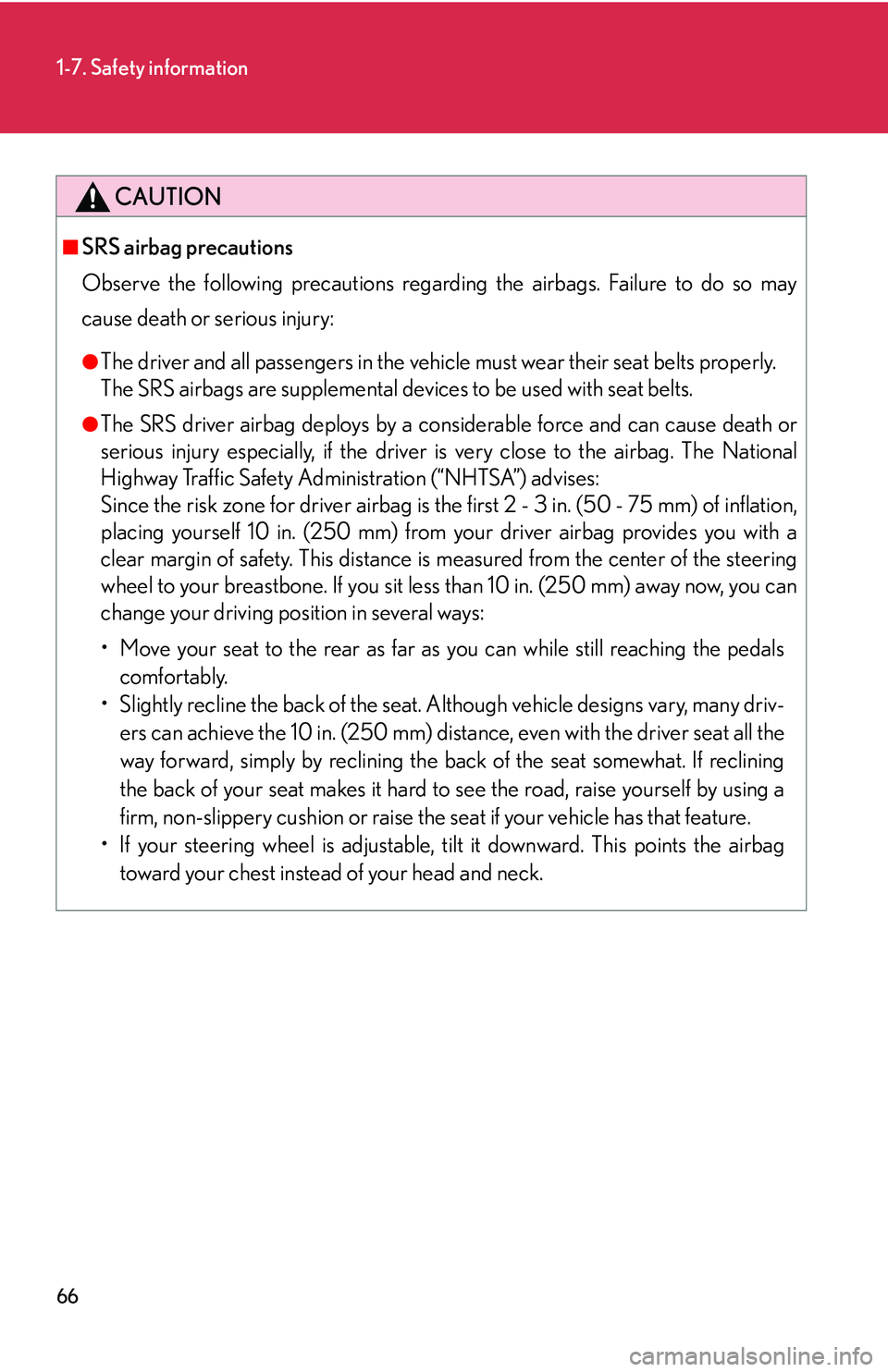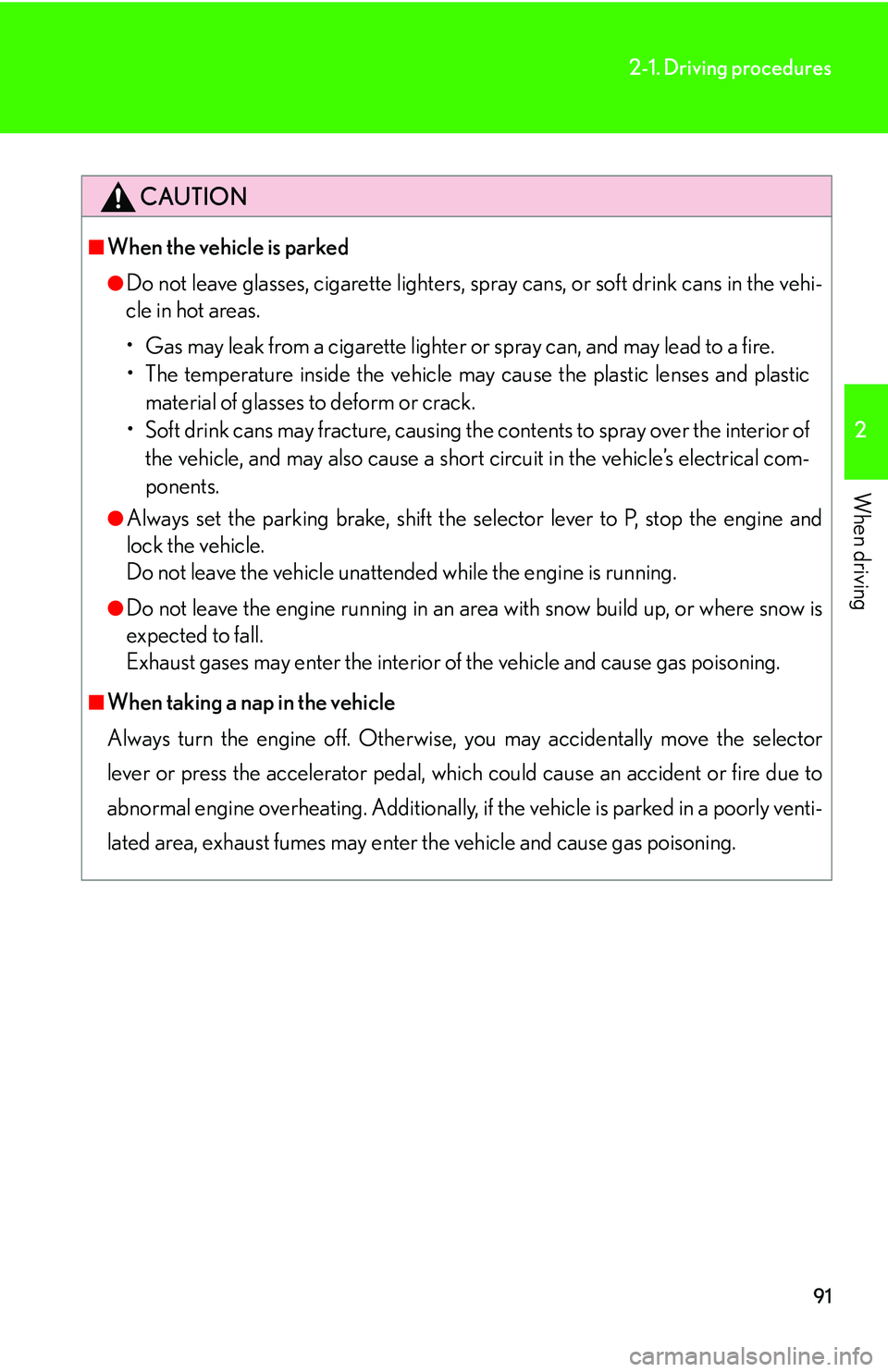Page 82 of 419

66
1-7. Safety information
CAUTION
■SRS airbag precautions
Observe the following precautions regarding the airbags. Failure to do so may
ca
use death or serious injury:
●The driver and all passengers in the vehicle must wear their seat belts properly.
The SRS airbags are supplemental devices to be used with seat belts.
●The SRS driver airbag deploys by a cons iderable force and can cause death or
serious injury especially, if the driver is very close to the airbag. The National
Highway Traffic Safety Administration (“NHTSA”) advises:
Since the risk zone for driver airbag is th e fi
rst 2 - 3 in. (50 - 75 mm) of inflation,
placing yourself 10 in. (250 mm) from your driver airbag provides you with a
clear margin of safety. This distance is measured from the center of the steering
wheel to your breastbone. If you sit less than 10 in. (250 mm) away now, you can
change your driving position in several ways:
• Move your seat to the rear as far as you can while still reaching the pedals
co
mfortably.
• Slightly recline the back of the seat. Alt
hough vehicle designs vary, many driv-
ers can achieve the 10 in. (250 mm) distance, even with the driver seat all the
w
ay forward, simply by reclining the back of the seat somewhat. If reclining
the back of your seat makes it hard to see the road, raise yourself by using a
firm, non-slippery cushion or raise the seat if your vehicle has that feature.
• If your steering wheel is adjustable, ti lt it do
wnward. This points the airbag
toward your chest instead of your head and neck.
Page 94 of 419
78
1-7. Safety information
Fully extend the shoulder belt and
then allow it to retract slightly in
order to activate the ALR lock
mode.
Lock mode allows the seat belt to
retract only.
While pushing the child seat into
the rear seat, allow the shoulder
belt to retract until the child seat is
securely in place.
After the shoulder belt has
retracted to a point where there is
no slack in the belt, pull the belt to
check that it cannot be extended.
Page 95 of 419
79
1-7. Safety information
1
Before driving
■Forward facing–Convertible child seats
Place a child seat on the seat fac-
ing the front of the vehicle.
Run the seat belt through the child
seat and inser
t the plate into the
buckle. Make sure that the belt is
not twisted.
Fully extend the shoulder strap and
then allo
w it to retract slightly into
the ALR lock mode.
Lock mode allows the seat belt to
retract only.
While pushing the child seat into
the rear seat, allow the shoulder
belt to retract until the child seat is
securely in place.
After the shoulder belt has
retracted to a point where there is
no slack in the belt, pull the belt to
check that it cannot be extended.
Page 99 of 419
83
1-7. Safety information
1
Before driving
Installation with child restraint lower anchorages
Move the seat fully back* (and
head restraint to the lower most
position).
* If equipped with power seats
Ty p e A
Widen the gap between the seat
cushion and seatback slightly
.
Latch the hooks of the lower straps
onto the anchorages.
Page 100 of 419
84
1-7. Safety information
Type B
Widen the gap between the seat
cushion and seatback slightly
.
Latch the buckles onto the anchor-
ages.
If the child restraint has a top strap, the top strap should be latched onto the
anchorages.
CAUTION
■To install correctly
When using the lower anchorages, be sure that there are no foreign objects around
the ancho
rages and that the seat belt is not caught behind the child seat.
Make sure the restraint system is securely
attached, or it may cause death or seri-
ous injury to the child in the even t of
a sudden stop or accident.
■Child restraint systems that can be installed using the lower anchorages
Child restraint systems conforming to FM V
SS225 or CMVSS210.2 specifications
can be used. This vehicle is designed to confirm to the SAE J1819.
Page 101 of 419

2When driving
85
2-1. Driving procedures ................. 86Driving the vehicle ...................... 86
Starting the engine ...................... 94
Automatic transmission ............ 98
Turn signal lever ............................ 101
Parking brake .............................. 102
2-2. Instrument cluster .................. 103 Gauges and meters .................. 103
Indicators and warning
lights ............................................. 105
Multi-information display ........ 107
2-3. Operating the headlight and
windshield wipers .................. 110
Headlight switch .......................... 110
Fog light switch ............................. 113
Windshield wipers and
washer ........................................... 114
Headlight cleaner switch.......... 117 2-4. Using other driving
systems ..................................... 118
Lexus park assist system ........... 118
Rear view monitor system....... 123
Cruise control .............................. 126
Dynamic radar/ laser cruise
control .......................................... 129
Electronically modulated air
suspension.................................. 138
Driver assist systems ................. 140
Pre-collision system
(if equipped) .............................. 143
2-5. Driving information ................ 145 Cargo & luggage ....................... 145
Vehicle load limits....................... 148
Winter driving tips...................... 149
Trailer Towing ............................... 152
Dinghy towing.............................. 160
Page 107 of 419

91
2-1. Driving procedures
2
When driving
CAUTION
■When the vehicle is parked
●Do not leave glasses, cigarette lighters, spray cans, or soft drink cans in the vehi-
cle in hot areas.
• Gas may leak from a cigarette lighter or spr
ay can, and may lead to a fire.
• The temperature inside the vehicle may cause the plastic lenses and plastic
m
aterial of glasses to deform or crack.
• Soft drink cans may fracture, causing the co ntents
to spray over the interior of
the vehicle, and may also cause a short circuit in the vehicle’s electrical com -
ponents.
●Always set the parking brake, shift the se lector lever to P, stop the engine and
lock the vehicle.
Do not leave the vehicle unattend ed
while the engine is running.
●Do not leave the engine running in an area with snow build up, or where snow is
expected to fall.
Exhaust gases may enter the interior of the vehicle and cause gas poisoning.
■When taking a nap in the vehicle
Always turn the engine off. Otherwise, you may accidentally move the selector
le
ver or press the accelerator pedal, which could cause an accident or fire due to
abnormal engine overheating. Additionally, if the vehicle is parked in a poorly venti-
lated area, exhaust fumes may enter the vehicle and cause gas poisoning.
Page 111 of 419
95
2-1. Driving procedures
2
When driving
■If the engine does not start
Check whether the other keys will start the engine.
If they work, your key may be broken. Have the key checked at your Lexus dealer.
■Starting the engine using the flat key (Smart access)
■ Steering lock release
When starting the engine, the igni -
tion switch may seem stuck in the
“L
OCK” position. To free it, per -
form the following:
Smart access
Push and hold the ignition
s
witch (do not try to turn the
ignition switch), then rock the
steering wheel until it releases.
Standard
Turn the key while turning the
steering wheel slightly in either
dir
ection.
Remove the flat key from its case.
Insert the flat key into the igni-
tions switch.
Start the engine within 10 sec-
onds after the indicator light goes
off.